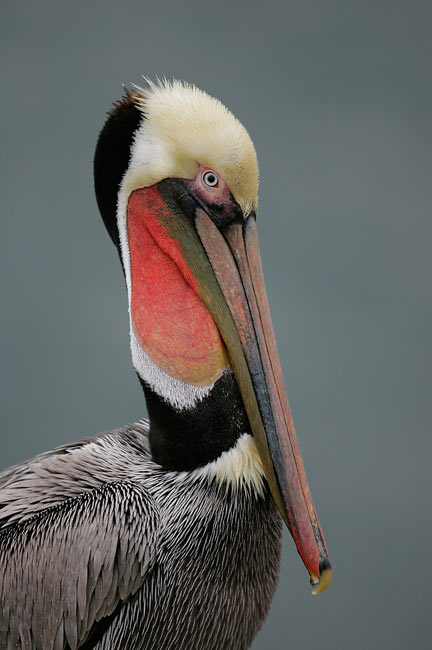
Brown Pelican, Pelecanus occidentalis.
Photo by Arthur Morris, Birds as Art.Birds in Science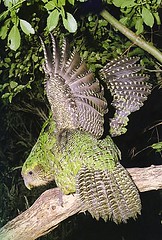
Two University of Canterbury biologists are part of a team whose
evolutionarily-informed approach to conservation is aiding the recovery of New Zealand’s critically endangered parrot, the kakapo,
Strigops habroptilus (pictured). Bruce Robertson and Neil Gemmell, Associate Professor of Biological Sciences, are members of a research team that has just had a paper published in the Royal Society of London’s prestigious journal
Biology Letters. The manuscript outlines how the team, led by Robertson, used sex allocation theory to remedy a conservation dilemma. A key prediction of sex allocation theory is that females in good condition should produce more sons. The kakapo, which today has a population of 86 located on a handful of small island sanctuaries, is the subject of much global conservation interest. They only breed every two to five years and about 58% of eggs do not hatch. Providing breeding females with extra food over the past decade has improved breeding frequency and chick survival, but at a recently-recognised cost: females in better condition were producing more sons. “Left unchecked, the recovery of this already male-biased species could be prolonged by more than 100 years, dramatically increasing the risk of losing this charismatic bird to extinction,” Dr Robertson said. Only females below a predicted breeding threshold weight were given
ad libitum food in the months before commencement of mating in mid-January to bring them up to the desired optimum weight. Females above the predicted breeding weight threshold were put on a diet to avoid raising their body condition to that previously associated with male-bias sex allocation. “This is a world first, using evolutionary theory to inform conservation practises and the first time anyone has used sex allocation theory to manipulate sex ratios with a critically endangered species. Our work has not only remedied the immediate problem of an overproduction of sons, but also highlights the value of incorporating evolutionary theory into modern conservation practice."
People Helping Birds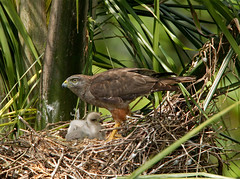
Ridgway's Hawk,
Buteo ridgwayi (pictured), is a forest raptor endemic to the New World island of Hispaniola. Once commonly distributed throughout the island, the hawk has been reduced in the last century to a
single declining population of 80 to 120 pairs, confined to less than 208 km
2 of native rainforest in the Dominican Republic's Los Haitises National Park. In 2004, the Peregrine Fund, York University (Canada) and the Sociedad Ornitológica de la Hispaniola initiated a research project to examine the nesting ecology and conservation genetics of Ridgway's Hawk. This is the first time that nests have been monitored in detail since the species was listed as Critically Endangered. Researchers found that human disturbance was the number one cause for nest failure for these critically endangered birds. [BirdLife Caribbean Newsletter
PDF 2.5 MB]
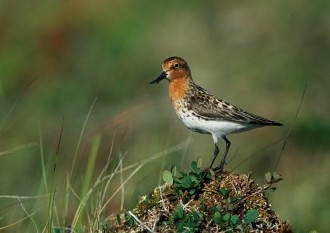
A team of international bird experts will begin surveying the Bangladeshi coast Tuesday in search of the
endangered spoon-billed sandpiper,
Eurynorhynchus pygmeus (pictured), whose population they believe has dwindled to just 350 pairs in the wild, organizers said Monday. The spoon-billed sandpiper, a small shore bird with a bill shaped like a teaspoon, lives and breeds in the Russian tundra. After a long, arduous journey of nearly 3,730 miles, these birds winter along the coastal areas of Bangladesh, India and Myanmar. The population of the species has been declining over the years for a
combination of reasons, and a 2000-2005 survey found an estimated 300-350 breeding pairs in sparsely populated Siberia, said Christoph Zockler from Cambridge, England who will lead the Bangladesh survey. "We ringed some young birds, but none returned home to breed. So what's going on?" said Zockler, who has been following the birds for five years. "We hope to uncover the mystery along the fly path." Enam Ul Haque, a Bangladesh water fowl census coordinator said; "We hope our survey will yield results that will help save them."
The biggest ever British Birdwatching Fair has produced
record funds for vital conservation work in the forests of south-east Asia. Over 18,000 bird-watchers and wildlife enthusiasts visited the British Birdwatching Fair in August 2005. The three-day annual event is held at Rutland Water and is jointly promoted by the RSPB (BirdLife in the UK) and the Leicestershire and Rutland Wildlife Trust. Martin Davies, the RSPB’s International Funding Unit manager and one of the organisers of the Bird Fair, expressed his delight at the contribution the event can make to international projects. "From the wetlands of Madagascar to the dry forests of Peru, conservation projects have been directly helped by funds raised at the Birdfair. British birdwatchers should be truly proud of what they have been able to help achieve," he said.
Stinky needs a
free ride to Florida, and soon. An Onslow County wildlife center in North Carolina is looking for help in transporting a juvenile brown pelican,
Pelecanus occidentalis (pictured at top), to a new home in Miami. "Stinky" was found starving and injured on the beach in Surf City in December, when he was just four months old. He now has an eight-foot wing-span and smells pungently of fish after recovering at Possumwood Acres in Hubert. The Pelican Harbor Seabird Station in Miami has agreed to take him. But transporting Stinky is the problem: Possumwood Acres can't afford the cost of moving the bird. Officials say a free flight would be the optimum solution to ensure that the bird is fed the way he needs to be during travel and to limit stress, while also providing great public relations for the airlines that decides to help out.
People Hurting Birds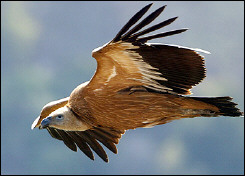
In India, Pakistan and Nepal, vultures are
teetering on the brink of extinction. Their rapid decline has been blamed on a veterinary drug, diclofenac, which the vultures ingest when feeding off treated cattle carcasses. New research shows the widely used anti-inflammatory drug is highly toxic to an entire family of vultures and may cause the birds' demise around the globe (pictured: Oriental white-backed vulture,
Gyps bengalensis). The situation was "extremely urgent," said Debbie Pain, a research scientist at the Royal Society for the Protection of Birds in England. "Populations of three vulture species affected by diclofenac in South Asia have declined by more than 97 percent since the early 1990s," Pain said. Vultures play a critical role in human and environmental health. For example, when cows die in India and Pakistan, it is custom to leave the carcasses where they are. In India, this is partly due to religious Hindu reasons because the cow is considered sacred. The rotting carcasses also become breeding grounds for diseases such as anthrax. "If a carcass is unconsumed for a day, anthrax within the animal has a chance to form spores, and these spores are incredibly resistant," said Rick Watson of the Peregrine Fund in Boise, Idaho. "That's how the disease spreads. So you set yourself up for increased incidence of disease -- both animal and human."
Birds Annoying PeopleTerre Haute, Indiana, has become the Panama City of
America’s crow population. But at least that Florida coastal town gets some economic jolt from the college students who flock there for spring break. While those kids might throw up on the Panama City sidewalks, they’re also spending money on hotels, food and party supplies. There are other cities on the crows’ list of vacation hotspots. For example, their roost in Auburn, NY, mushroomed to 63,000 birds in 2004 before that town took action. “They seem to like to come into the city,” Auburn Mayor Tim Lattimore said by telephone last week. “They’re very intelligent birds. Very social birds. On weekends, their cousins fly in to visit.” Their tactics included using pyrotechnics similar to those in Terre Haute, accompanied by recorded crow distress calls and handheld laser lights. Auburn paid the New York USDA division $13,000 for the work, but the federal agency spent $32,000 itself on the project. It worked. “It was a real positive experience,” Chipman said.
Avian Influenza News Much has been written in recent months about the role of wild birds in spreading the Highly Pathogenic Avian Influenza (HPAI) H5N1 virus. But there is a
distinct lack of evidence to support these assertions. "No species migrates from Qinghai, China, west to Eastern Europe," says Dr Richard Thomas, BirdLife International's Communications Manager. "When plotted, the pattern of outbreaks follows major road and rail routes, not flyways. And the absence of outbreaks in Africa, South and South-East Asia and Australasia this autumn is hard to explain, if wild birds are the primary carriers." Movement of infected poultry and poultry products is a likely cause of spread. South Korea and Japan are two countries to have suffered outbreaks of H5N1 in poultry and wild birds following importation of infected duck meat. Both countries stamped the virus out by culling infected poultry around disease areas, and imposed strict controls on poultry and poultry meat imports. "Neither country has suffered a recurrence of the virus despite the influx each autumn of hundreds of thousands of wild migrant birds," Richard Thomas points out. GrrlScientist note:
I have been saying this very thing for years, based on traditional migratory paths of wild birds compared to the dates and locations when influenza outbreaks are first identified. It's about time that this information becomes more widely known and accepted.The World Health Organization (WHO) said on Monday it expected more human cases of bird flu following the death of four people in Turkey, but said the risks to humans were steadily diminishing. The WHO confirmed laboratory test results in Ankara, which revealed that
four people from two families in eastern Turkey died of bird flu this month and a further 16, mostly children, were infected with the H5N1 virus. "We do expect to see some (more) cases because it takes time before the virus in birds has completely disappeared," said Dr. Guenael Rodier, head of the WHO mission to Turkey and an expert in communicable diseases. Human victims had been confined to East Asia until this month, when three infected children from the same family died in eastern Turkey, showing the deadly H5N1 strain had reached the crossroads of Europe, Asia and the Middle East. "Now is the right time to look beyond outbreak control to look at medium- and long-term efforts, particularly on the animal side, and also keep a constant surveillance in Turkey and neighbouring countries," he said.
Would you estimate the percentage of movie fans in the world by polling at a cinema? Would you calculate the number of overweight Americans by taking a survey at Weight Watchers locations? Not if you were aiming for any sort of statistical accuracy; such methods would not give you samples at all representative of a larger population. Regrettably, just this sort of sampling bias may have lead to huge errors in avian flu mortality numbers. While stony-faced newscasters somberly report that more than 50% of people infected with avian flu ultimately die,
the death rate may be much lower. A study published in the January 9th issue of Archives of Internal Medicine found that as many as 600 to 750 people in Vietnam may have come down with a mild variant of the avian flu—one that does not carry lethal consequences. This suggests that current mortality estimates, which are derived from only the most severely ill patients, are biased. We may be underestimating the virus' transmission rate while overestimating the deadliness of avian flu. "Our study suggests that this milder form may be more prevalent than the more deadly disease that we heard about earlier," said Anna Thorson, a researcher at the Sweden's Karolinska University Hospital and lead author of the study.

Thousands of chickens mysteriously dropped dead at several farms in Trinidad over the last four weeks but authorities
ruled out the deadly bird flu virus as the cause. "What they are saying to me is that [avian influenza] is not to be worried about," Narine told a local radio station. Narine said health officials believed the chickens in Trinidad were dying because of a fungal disease of the respiratory tract caused by
Aspergillus fumigatus, a kind of mold (pictured). GrrlScientist note:
Aspergillosis infection is very common in birds kept in conditions with overcrowding, poor hygiene and with little or no ventillation. In two words; chicken farms.Streaming Birds The schedule for this week
The schedule for this week on
BirdNote is .. Monday, the call of the loon; Tuesday, seabirds in decline; Wednesday, migratory owls; Thursday, Bohemian Waxwings,
Bombycilla garrulus; and Friday, a swirl of Snow Geese
Anser caerulescens. BirdNote programs are two-minute vignettes that incorporate the rich sounds of birds provided by Cornell University and by other sound recordists, with photographs and written stories that illustrate the interesting -- and in some cases, truly amazing -- abilities of birds. Some of the shows are Pacific Northwest-oriented, but many are of general interest. BirdNote can be heard live, Monday through Friday, 8:58-9:00AM in Western Washington state and Southern British Columbia on
KPLU radio and now also in North Central Washington state on
KOHO radio. All episodes are available in the BirdNote archives, both in written transcript and mp3 formats, along with photographs. Listener ideas and comments are
welcomed. [mp3/podcast].
Ivory-billed Woodpecker NewsJerome Jackson's long anticipated comments regarding the Ivory-billed Woodpecker have finally been published by the
Auk (123:1-15, 2006), one of three top-tier ornithological journals in the world. This article is publically available as a
free download courtesy of the
American Ornithologists' Union. [PDF, 15 pp.] The cover, which features the art of Julie Zickefoose, for this issue of
Auk will appear here as soon as it is released.
Parrots in the NewsParrots were big in the news this week. Our first story is about a pet parrot who attacked a man who broke into its owner's apartment, and the resulting bite and blood marks helped police identify the suspect. A
blue and gold macaw hybrid named Sunshine attacked Michael L. Deeter, 44, after he broke into the apartment, police said. Sunshine had blood on its beak and Deeter had marks on his hand consistent with those made by a parrot. Deeter told police the bird bit him very hard after he entered James Erb's apartment and he still had the marks to prove it when he was arrested, authorities said. He allegedly got away with about $100 and a camcorder. As for the bird, Sunshine did not come away unscathed -- all but one of its large tail feathers had been pulled out.
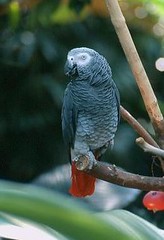
Our second parrot story describes how a gossipy parrot split up a pair of lovebirds when a computer programmer discovered that his girlfriend was having an affair when his
pet parrot kept repeating her lover's name. The African grey parrot,
Psittacus erithacus (pictured), named Ziggy, kept repeating "I love you, Gary" as his owner, Chris Taylor, sat with girlfriend Suzy Collins on the sofa of their shared flat in Leeds, northern England. But when Taylor saw Collins's embarrassed reaction, he realized she had been having an affair -- meeting her lover in the flat whilst Ziggy looked on. Ziggy even mimicked Collins's voice each time she answered her telephone, calling out "Hiya Gary," according to newspaper reports. "I wasn't sorry to see the back of Suzy after what she did, but it really broke my heart to let Ziggy go," Taylor said. Taylor revealed that he had also parted from Ziggy because the bird continued to call out Gary's name in his ex-girlfriend's voice, media reports said. GrrlScientist note;
this is actually an old news story that I've linked to in Birds in the News
, issue 38. But this time, I received 8 or 9 reader recommendations to include this link in this issue, more than I've ever gotten for any news story since I've been putting these things together, so here is the story again, by popular demand. 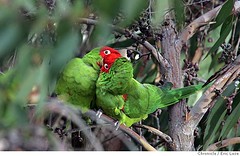
Our third parrot story tells how the movie star parrots (pictured, photo by Eric Luse) from San Francisco's Telegraph Hill just might get a happily-ever-after ending to the
real-life saga of their favorite trees. In a finale fit for a sequel to their big-screen debut, the birds' beloved Monterey cypresses appear close to being spared from the ax. "We want to save those trees," said Mark Bittner, who wrote the best-selling book about the colorful birds and co-starred with them in a popular documentary film. The parrots "are my friends, and if I didn't help them, it would be absurd." An agreement could be reached as early as this week in a highly publicized, long-running feud between a property owner who wants to chop down the cluster of trees he sees as a liability and parrot lovers so intent on saving them that they have thrown themselves in front of buzzing chain saws. "It's a very emotional issue," Foster said. "On one side you have a group that has a relationship with the birds, and on the other hand you have a property owner with a liability issue."
Miscellaneous BirdsUS Geological Survey has a National Wildlife Health Center webpage listing a variety of
free books about animal health issues for download as PDFs in English, Spanish and Italian. Included in this listing is the beautifully illustrated 30-page
Avian Necropsy Manual for Biologists in Remote Refuges [PDF, 2.87 MB], as well as important online information such as
Coping with Diseases at Bird Feeders.
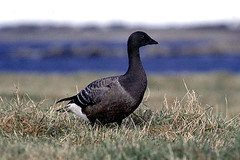
Fewer migrating ducks, geese and wading birds are wintering in the UK because they are staying closer to their Arctic breeding grounds due to
climate change. New studies by the British Trust for Ornithology (BTO) and the Wildfowl and Wetlands Trust have revealed that ducks, geese and waders are attracted by the relatively warmer winter conditions in the Gulf Stream that protects the British Isles but, claims the BTO, global warming could be persuading migrating birds to stay in cooler northern and eastern waters. Signs are growing that all is not well for a range of geese, ducks and wading birds. Species such as the grey (black-bellied) plover,
Pluvialis squatarola, and dark-bellied brent goose,
Branta bernicla bernicla (pictured), whose populations peaked in the early 1990s, after long periods of increase, numbers are now declining steadily.
With more than 18,000 collectible owl memorabilia, Pam Barker half-kiddingly thought she might have a world's record. The Guinness Book of World Records has now certified that
she was right. Barker, 47, sent her count, a video and photographs to Guinness last spring. A couple of weeks ago, she got a certificate verifying her claim. The collection - all 18,055 items - had been owned by Dianne Turner, a collector who had recently died. A family friend was cleaning out the house and put the owls up for sale for $7,000. Barker offered about half. Although Barker didn't know Turner, she's put the world record in Turner's name. "Her husband gave her three owls after they got married," Barker said. "That started it all." Barker is now selling off the collection, and has priced everything in the store. She'll sell it piece-by-piece if she has to, although she'd like to find a home for the entire collection. "My husband would like his store back," she said.
This week, the
300th installment of "This Week at Hilton Pond," the ongoing series of photo essays about natural history in the Carolina Piedmont -- and beyond. This week, the Piedmont naturalists describe a very unusual bird captured for banding at Hilton Pond Center for Piedmont Natural History near York, SC. They include a mini-quiz and photos of this mystery bird on their site, a tally of birds banded during the week, plus some miscellaneous nature observations.
The Fine Print: Thanks to my bird pals, Ian, Mary, Arpit, Christine, Mike, Bill, Caren, Sara, Ellen and Ron for some of the news story links that you are enjoying here. Thanks to Ian for fact-checking this document.
I also appreciate long-time readers, Jamie, Tony and anonymous blog reader, for nominating Birds in the News
for a 2005 Koufax Award for Best Series! Voting will probably begin at the end of January. There will be an announcement here, along with more details, when voting begins.Previous : : Birds in the News : : Next
tags: Birds in the News, ornithology, birds, avian, newsletter

 Survival Job Applications:
Survival Job Applications: none this week. After an unending stream of negativity and rejection, I decided to begin my first formal week of unemployment in 2006 by hiding in snowy Morris, Minnesota, thanks to help from a lot friends (I've actually been unemployed since 23 December 2005 but was too depressed to register with the unemployment office until last week).



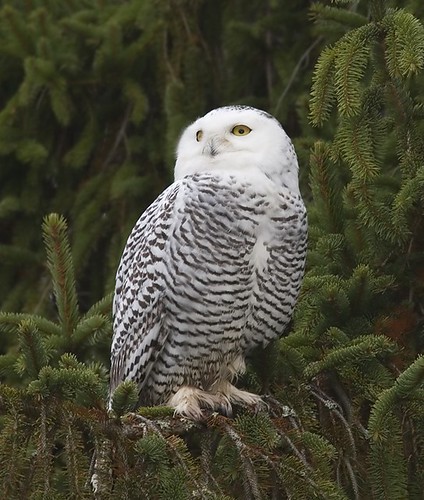
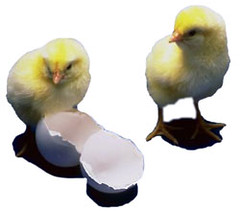
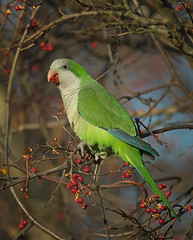
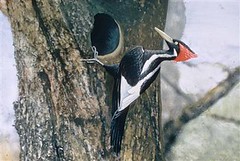 As scientists debate whether the ivory-billed woodpecker, Campephilus principalis (pictured), still exists in the Big Woods of Arkansas, environmentalists have enlisted the bird as a key soldier in their fight against a
As scientists debate whether the ivory-billed woodpecker, Campephilus principalis (pictured), still exists in the Big Woods of Arkansas, environmentalists have enlisted the bird as a key soldier in their fight against a 

 The parents of Toga -- the
The parents of Toga -- the  While the cost of
While the cost of 


 Two University of Canterbury biologists are part of a team whose
Two University of Canterbury biologists are part of a team whose  Ridgway's Hawk, Buteo ridgwayi (pictured), is a forest raptor endemic to the New World island of Hispaniola. Once commonly distributed throughout the island, the hawk has been reduced in the last century to a
Ridgway's Hawk, Buteo ridgwayi (pictured), is a forest raptor endemic to the New World island of Hispaniola. Once commonly distributed throughout the island, the hawk has been reduced in the last century to a 


 Our second parrot story describes how a gossipy parrot split up a pair of lovebirds when a computer programmer discovered that his girlfriend was having an affair when his
Our second parrot story describes how a gossipy parrot split up a pair of lovebirds when a computer programmer discovered that his girlfriend was having an affair when his  Our third parrot story tells how the movie star parrots (pictured, photo by Eric Luse) from San Francisco's Telegraph Hill just might get a happily-ever-after ending to the
Our third parrot story tells how the movie star parrots (pictured, photo by Eric Luse) from San Francisco's Telegraph Hill just might get a happily-ever-after ending to the 










